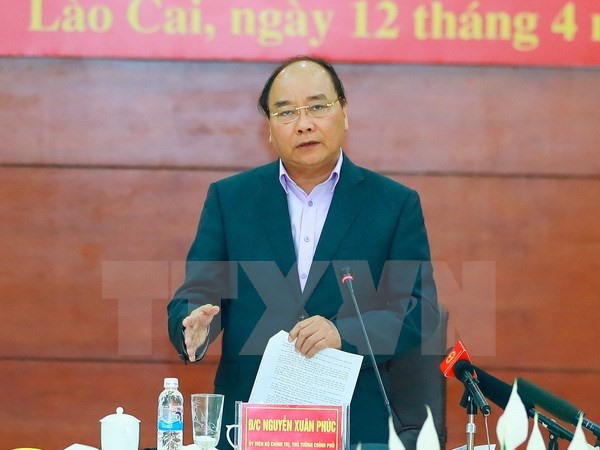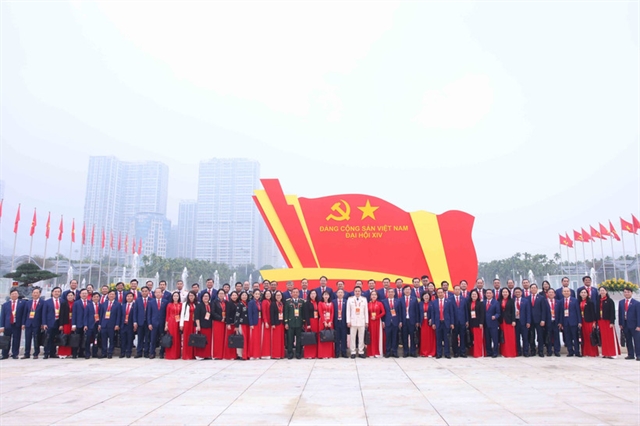 Society
Society

Prime Minister Nguyễn Xuân Phúc has urged ministries, sectors and localities to seek measures to promote traditional herbal medicines, thus taking advantage of the country’s potential in the field.
 |
| Prime Minister Nguyễn Xuân Phúc delivers speech at a teleconference with leaders of 63 cities and provinces nationwide held in the northern province of Lào Cai on Wednesday. — VNA/VNS Photo Thống Nhất |
LÀO CAI — Prime Minister Nguyễn Xuân Phúc has urged ministries, sectors and localities to seek measures to promote traditional herbal medicines, to take advantage of the country’s potential in the field.
Addressing a teleconference with leaders of 63 cities and provinces nationwide held in the northern province of Lào Cai on Wednesday, the PM noted that for thousands of years, Việt Nam has used herbal medicines.
With three quarters of its natural area mountains and forests, Việt Nam has more than 5,000 herbal plants with medicinal value, which are a great advantage for localities to exploit the resources for domestic use and exports, he said.
PM Phúc affirmed that traditional medicines are a treasure of the country, which can contribute to poverty reduction.
He asked for solutions to tackle problems facing the sector, including poor planning in developing production chains that leads to low effectiveness and small-scale production as well as difficulties in markets, risk of extinction of many rare herbal plants and limited use of advanced technology in the field.
The government leader also called for support policies for herbal plant growing as part of high technology agriculture development, while stressing the need to ensure confidentiality of some rare and precious herbal plants.
He suggested three centres for traditional medicine research be set up nationwide, asking ministries, sectors and localities to raise public awareness of traditional medicine and encourage innovation and entrepreneurship in this field.
It is also a must to tighten control of the trade and distribution of herbal medicinal materials to prevent smuggling and protect domestic herbal medicine production, he said.
Representative from many provinces said they will turn herbal medicine development into one of the economic priorities so as to tap into local advantages.
An official of central Quảng Nam Province, which is famous for Ngọc Linh ginseng (Panax vietnamensis or Vietnamese ginseng), said it is necessary to expand and upgrade transport infrastructure to attract investment in developing this rare indigenous species.
Home to nearly 1,000 medicinal plant species, northern Quảng Ninh Province asked the Government to increase support for businesses and local households to tap into this resource, enhance the training of specialised pharmacists, and promote the trade of Vietnamese herbal medicine in the region and the world.
Meanwhile, the northernmost province of Hà Giang considers herbal medicine development as a start-up priority, an official said, adding that they have contracted research institutes to develop products from local herbal plants.
According to the Institute of Medicinal Materials, Việt Nam has 5,117 herbal plants and fungus, along with 408 species of animals and minerals used as materials for nearly 1,300 traditional remedies.
Domestic demand for herbal medicinal materials is about 60,000-80,000 tonnes per year, mostly for producing foods, medicines and cosmetics. The Ministry of Health assessed that the economic value of herbal plants is much higher than other food plants, suggesting that sustainable growing will help reduce poverty for many regions.
Yesterday, Phúc also instructed the northern province of Lào Cai to focus on developing its tourism industry, which is considered a key economic sector in the fight against poverty and the promotion of the cultural identities of ethnic minority groups in the northwestern region.
Tourism should contribute 30 per cent to GDP, he said at a working session with local authorities.
Tourism contributed to 11.5 per cent of the province’s GDP in 2010-2015. In 2016, Lào Cai welcomed 2.77 million tourists, up 33 per cent from 2015. The province has set a target of welcoming 6 million tourists by 2020.
Lào Cai is expected to become a key tourism centre of the northwestern region by 2020, with Sapa becoming a national tourism site.
The PM also instructed the province to boost border gate economic development.
Promoting border gate economic development was a way for Lào Cai to build the locality into a commodity entrepôt for countries in the Mekong sub-region and China as well as a modern logistics centre for the region, with a system of seaports, airports, railways and road transport, he said.
He asked Lào Cai to deal with issues relating to the environment and social security and strive to fulfill its socio-economic tasks in 2017, particularly in completing the disbursement of investment capital for infrastructure development.
Responding to the province’s proposals, PM Phúc agreed to invest in developing the Lào Cai border gate economic zone into a commodity entrepôt for countries in the Mekong sub-region. — VNS




